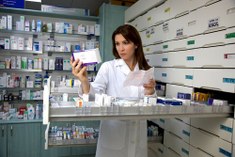Impact success story: Drug development
Pharmaceutical companies are easily depicted as only out for profit. Business developer Dominic De Groote believes that we should take a new look at that image. “Certainly the larger companies are aware of their impact on society.”
Dominic De Groote works every day as a business developer in the area of tension between academic output and commercial interest. “If you look at the market, many pharmaceutical blockbusters originate from a university, but many interesting things die on the way and never find their way to the market. One of the stumbling blocks lies in the nature of the mission of academics: it is not their primary job to ensure that new medicines are commercialised.”
Moreover, many universities are too small to even bring new medicines to a level that interests companies. “It’s very risky and requires a lot of resources, which means that only the very large universities can enter the field. This is why universities are encouraged to set up centres that work as accelerators.
Connecting partners in service of the patient
“This is necessary,” Dominic De Groote agrees, “because companies rarely try to push the boundaries themselves, but once they have been moved, they make something concrete. That’s how the interactions work. We push the boundary and they operate just behind it.” That’s why Dominic De Groote now mainly brings people into contact with each other, “Because it is still people work. We have defined a number of sub-domains, including cancer research, in which we now look very specifically at the specific expertise of each partner and what projects are possible in that context. This is socially relevant because that way we can more easily get discoveries based on university research to companies, and via those companies to the market. This ultimately benefits the patient.”
Risk-free, non-profit research
Universities mainly look for new technologies and do research on topics that are often too risky for companies.
Dominic De Groote: “This brings you into the domain of spin-offs. A good example is gene therapy. Defects at the level of DNA cause hereditary diseases. New techniques are now possible to replace defective genes. This is a new type of technology that large companies do not pick up quickly. We then prepare a business plan for a new company and contact investors looking for a high risk with a high return.”
“I’d say we are lucky to be able to do this risky research. We don’t have to think in terms of profit at the university.”
A Ghent University team led by professor Jean-Paul Remon (now in retirement) already developed a new malaria pill for children some ten years ago - an important risk group but not easy patients to work with. The revolutionary thing about the pill was the fact that the scientists had processed the quinine in the pill in such a way that this crucial substance no longer tasted bitter. In addition, the tablet could easily be broken into smaller pieces to administer the correct dose. In the end, the university donated the technology for free.
In an interview for the Ghent student magazine Schamper, doctoral student Egide Kayitare and Professor Jean-Paul Remon explained why this was so important: “Given that the pill is intended for children, it was necessary to be able to prepare the doses based on their body weight. Ultimately, the research led to a tablet in the shape of a small waffle that can be broken into eight parts. In this way, the correct dose can be administered both to infants weighing around 2.5 kg and children up to around 20 kg.”
Not only people but also animals
All large companies have their own public health leg, each with their own priorities. They often partner up with an intermediary philanthropic organisation that manages the initiative. Dominic De Groote speaks with those intermediaries first. For example, one of Ghent University’s research groups is working on a medicine for sleeping sickness. The group developed a compound that is just as powerful and effective as the best medicine currently used. That medicine is less toxic, works well and does not have much resistance to it.
There are already three drugs for sleeping sickness. The most recent is less toxic and works well - without much resistance to it - so the need for a new drug is slightly lower at the moment, which does not mean that new problems with resistance will not arise sooner or later. The incidence of sleeping sickness has also fallen sharply. So progress has already been made and a good compound is available, which is precisely why companies will be less inclined to put extra money on the table for future remedies against sleeping sickness.
“The figures provide less motivation and there are greater problems than sleeping sickness, but it’s a different story for the veterinary sector. There’s currently no good alternative in that area. The loss of cattle is very high, especially in the sub-Sahara. We are now looking at whether our medicine or a variant of it could also be useful in cattle.”
Why is this important? In some countries the affected cattle is one of the main sources of protein. Small farmers in particular have little margin when things go wrong with their animals. That’s why one of the large pharmaceutical companies with which Dominique De Groote cooperates is also focusing on training farmers and veterinarians in developing countries so that they can more quickly recognise and treat sleeping sickness in their cattle and ensure that animals are less likely to be stung by the insects that transmit sleeping sickness. This therefore goes much further than just providing medicines.
Dominique De Groote: “The social objective is not to make money there, but to ensure that we have an impact. But time and time again, you have to find a company that wants to support and finance the project, because in fact they won’t get their money out of it.”
